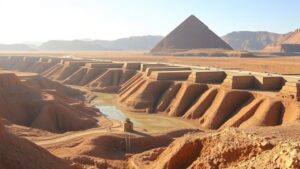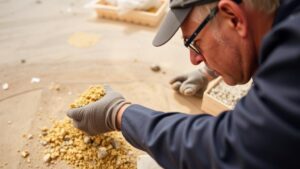The Use of Dolabra and Pickaxes in Roman Mining Operations
The Use of Dolabra and Pickaxes in Roman Mining Operations
The mining operations of ancient Rome were critical to the empires economic and architectural success. Among the tools that facilitated these operations, the dolabra and pickaxes were fundamental. This article delves into the specific uses of these tools, their design and construction, and their impact on Roman mining practices.
Overview of Roman Mining Practices
Mining in ancient Rome was a highly organized industry that played a key role in supplying the resources necessary for construction, metalwork, and trade. Romans mined various materials, including gold, silver, lead, copper, and iron. The extraction process often involved extensive underground tunnels and open-pit strategies. Two essential tools in these operations were the dolabra and pickaxes, which were adapted to meet the demands of different mining environments.
The Dolabra: Design and Function
The dolabra was a versatile tool primarily used for both mining and construction. Its design featured a wide, flat blade that resembled a modern-day pick or hoe. The tool’s construction allowed it to break and excavate soil effectively, making it particularly useful in soft earth mining.
- Materials: The dolabra was typically made of iron or steel, ensuring durability and strength. Its handle was often constructed from sturdy wood, often measuring around 1.5 to 2 meters long.
- Versatility: The dolabra was not only applicable in mining but was also used in agricultural contexts. This multifunctionality made it an essential tool for the Roman labor force.
Pickaxes: A Specialized Tool for Harder Materials
In contrast, pickaxes were utilized predominantly for breaking harder rock formations that contained valuable minerals. Roman pickaxes featured distinct designs, with a pointed end ideal for penetrating solid rock and a flat blade for removing the loosened material.
- Variations in Design: Depending on the target material, pickaxes could vary significantly. For example, a pickaxe designed for tunneling in gold mines would differ from one meant for iron ore extraction.
- Efficiency: The pointed end of a pickaxe allowed miners to apply force efficiently, preventing excessive exertion and increasing productivity in harsh mining conditions.
Case Studies: The Use of Tools in Specific Roman Mines
Several historical sites reveal the prominence of the dolabra and pickaxes in Roman mining. One notable example is the gold mines of Dolaucothi in Wales, where archaeological findings indicate that both tools were extensively utilized.
- Dolaucothi Gold Mines: Evidence suggests that workers employed dolabra for surface operations, while pickaxes were used for deeper, more labor-intensive extraction tasks.
- Las Médulas in Spain: Here, the Romans used a combination of water and tools to extract gold from pyrite-rich sediments. The dolabra played a critical role in managing the earth that was disturbed during this process.
The Impact of Tools on Mining Efficiency
The effective design and use of the dolabra and pickaxes significantly increased mining efficiency in ancient Rome. Studies suggest that the advancements in tool technology contributed to a more organized and improved extraction process, resulting in higher yields of precious metals and minerals.
Conclusion: Lasting Legacy of Roman Mining Tools
The dolabra and pickaxes were more than mere tools; they represent the ingenuity of Roman engineering and the empires ability to adapt to diverse mining challenges. r legacy continues to influence modern mining practices, demonstrating the long-standing connection between tool design and resource extraction.
For those interested in archaeology or mining history, understanding the role of these instruments can provide valuable insights into Roman technology and labor practices.


